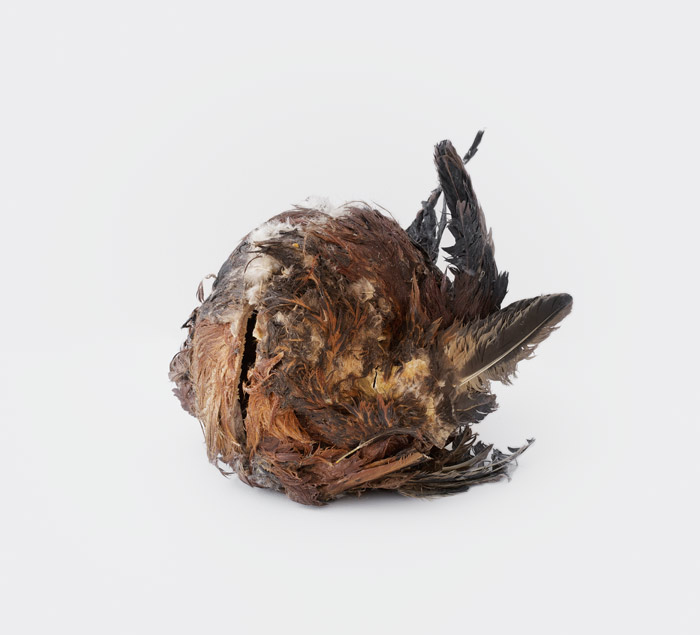I was once in a car crash. While foolishly attempting to cross two lanes of traffic to catch my exit, the rear end of my little two-seater got clipped by a truck, which sent me spinning nearly 360 degrees. Remarkably, my car suffered only a minor dent, but I was left with a sense of my own lightness, an awareness of my own fragility in relation to the fixity of inanimate objects. Judging by his recent show at Clifton Benevento gallery, it seems as if the artist Michael E. Smith is acutely sensitive to this issue of human weightlessness, as his sculptural installations combine manmade and organic materials in dark and humorous ways suggestive of mortality and transience.
For his second show at this 6th floor SoHo gallery, Smith has once again removed all extraneous objects from the gallery space. Most notably, he cleared out the floor to ceiling bookshelves that cover a corner of the gallery. While the artist placed a handful of objects on the shelves, he left most of them vacant, turning the segmented shelves into a sculptural element in their own right. Located smack in the middle of the shelving unit is the center console from a Chrysler Town and Country minivan, a vaguely familiar hunk of plastic that teeters over the edge of the windowsill upon which it rests. This enigmatic object is both more and less fixed in space than it appears: safely mounted upon an invisible ball bearing device, visitors are invited to nudge the untitled sculpture so that it spins smoothly in place, playfully evoking the horrific experience of being in a car that is spinning out of control.
This mixture of whimsy and morbidity characterizes the show as a whole. For instance, for the dual sculptures titled LBS and RBI (as in “left brain side” and “right brain side”) Smith sawed two MacBook computers in half and placed them next to one another on one of the shelves. He also sawed perfectly circular holes into the laptops’ touch pads, and filled the holes with circular chunks of human skull, (a material which can be purchased both for research and for artistic purposes, apparently).
Ostensibly, Smith emptied out the bookshelves to prevent art history from breathing down his neck, but in actuality, I believe he did it to lend his delicate sculptures the appearance of increased weight. Who among us, after all, can resist the zen-like vacuity of an empty gallery, that curious space which elevates its sparse contents to the status of something special, something capable of transcending the daily grind? Although Smith is certainly capitalizing upon the sanctifying power of the white cube, the thoughtful ways in which he engages with the space serve to remind us that the gallery is a lived-in place where humans act out both their most lofty ambitions and their most profane functions.
In an untitled installation in the gallery bathroom, Smith carefully placed half a dozen metal tubes in a row on the edge of the bathtub. The multicolored tubes are in fact handsaws with the blades removed, and the saws themselves have been sawed at different points and placed in order of descending length. The fact that they are placed on the edge of the bathtub evokes the precariousness of the Chrysler console in the main room, and it also draws attention to the fact that there is a bathtub in the bathroom. We are reminded that this place was once an apartment, a place where people used to live, and a place where people still live and work to this day.
The tension between the sacred and the profane, as well as the tension between life and its opposite, is further engaged in the sculpture Mike (all works in the show were created in 2013, and while Smith usually leaves his works untitled, he indulged in titling quite a few of them this time). Although you would never guess it just by looking at the sculpture, Mike makes reference to “Mike the Headless Chicken,” a chicken that survived for 18 months after its head was cut off in 1945 (the farmer who did the beheading kept the chicken alive by feeding it milk through an eye dropper). For the sculpture Mike, Michael Smith sawed a mannequin’s head in half and affixed a headless rooster pelt to each side of the plastic “skull”. The morbidity of this gesture is undercut by the sculpture’s placement on the floor, where it functions as a doorstop just within the entrance to the gallery.
Bird parts appear elsewhere in the show: five chicken pelts have been coated with black rubber and affixed to a medium sized canvas that has been hung up near the ceiling in the far corner of the gallery. Two ostrich eggs sit on one of the shelves across the room; one of them has a hole in it, which makes them look a little bit like a pair of eyes staring up at the chicken painting in the corner. Clearly Smith has a knack for tying together materials and themes, such that the show functions more like a cohesive installation than a collection of discreet works. It should be noted that the relative emptiness of the gallery space, and the semantic games taking place therein, are particularly liable to annoy those who don’t take pleasure in contemporary art. That’s why I don’t buy the line about banishing art history from the gallery: clearly, you need to appreciate a good ready-made in order to enjoy this show. However, for those of you who have a taste for that sort of thing, the work of Michael E. Smith is guaranteed to leave you grinning.
By David A. Willis
























